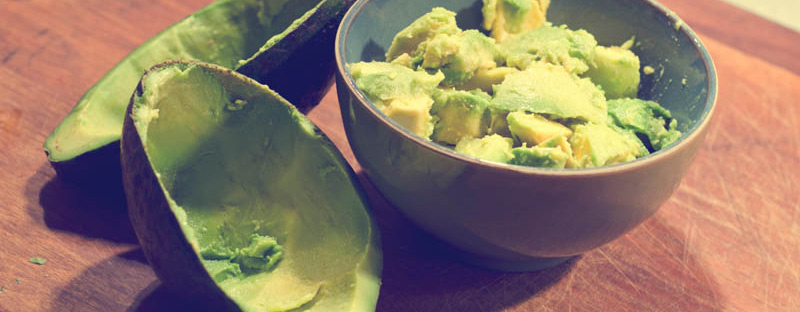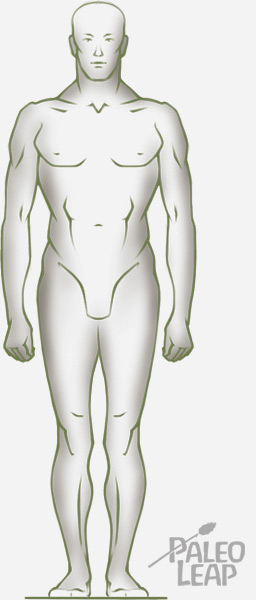Yes, gain. In the modern world, it’s much more common to be dangerously overweight than dangerously underweight, and so the vast majority of diet advice is dedicated to losingpounds, not putting them on. But there are still people – in fact, a surprisingly large number of them – who have exactly the opposite problem.
People trying to gain rather than lose on Paleo usually fall into one of two categories. Some are unhealthy because they’re too far below a normal weight (suffering from Celiac disease or other malabsorptive problems, recovering from anorexia, or otherwise ill). They want to gain fat and muscle – any kind of additional weight will be good news. Others are perfectly healthy, but trying to gain muscle mass for athletic performance. They’re usually only interested in gaining muscle (not fat), and they also have a lot more options, since their health isn’t on the line.
Adapting Paleo to address either of these problems can be tricky, because almost all the published books and research focus on weight loss. Some doctors will even tell you that you can’t gain a significant amount of weight on Paleo, because the food isn’t calorie-dense enough (too manyvegetables; too hard to overeat – for most people, these are perks!).
Those doctors have a point, but only to a certain extent. Extreme calorie surpluses are difficult using only Paleo foods. 4,000 calories or more would realistically require at least some kind of supplementation. Paleo simply won’t support the eye-popping calorie intake of a professional powerlifter: if you want to create an unnaturally muscular physique, you’ll need an unnatural diet to make it work. On the other hand, Paleo is an appropriate diet for all kinds of health-centric weight gain, including the natural muscle-building of a well-designed strength program or recovery from chronic diseases.
Healthy Weight Gain: Heal your Gut
Whether you’re medically underweight or looking to build more muscle, step 1 in either case is to make sure everything in your gut is humming along smoothly. You benefit from the calories and nutrients you absorb, not the ones that enter your mouth, so just eating more food won’t always help. Patients with Crohn’s Disease, for example, often have trouble absorbing not only macronutrients (fat, protein, and carbohydrates), but also micronutrients (for example, 35-90% of Crohn’s sufferers are iron-deficient). This explains why many struggle to maintain a healthy weight despite eating enough food.
Gut healing can be a long, painful, and frustrating process, but unfortunately there are no workarounds. Just taking out gut-irritating foods like grains, legumes, and dairy (if you’re sensitive to dairy) is a great first step. If that still doesn’t help, take a look at this article for some suggestions for healing your gut. You’ll only get the benefit of eating high-calorie foods if your gut has healed enough to absorb them, so make sure you take care of this step first before you go on to anything else.
Paleo Nutrition for Healthy Weight Gain: Fat
Once you’ve healed your gut, it’s time to focus on the nuts and bolts: how to get enough calories down the hatch. Paleo food has a reputation for being calorie-poor, but this isn’t quite accurate. There are plenty of healthy calorie-dense foods. The problem is really that whole, natural foods are difficult to overeat, and if you want to gain weight, by definition you have to overeat relative to your body’s maintenance requirements.
Starting off the “high-calorie healthy food” parade are the fats. One major reason why people still believe the “fat makes you fat” myth is that a gram of fat contains 9 calories, while a gram of protein or carbohydrate contains 4. Fat, in other words, is more than twice as calorie-dense as the other two macronutrients.
The reason that this doesn’t actually make you fat is that when people eat according to hunger, they naturally eat smaller amounts of fatty foods. So everything evens out. Fat is not a one-way ticket to weight gain (whether you want it or not). But the calorie density does make it a useful tool for putting on healthy mass, because it doesn’t take up as much room in your stomach. You still won’t feel hungry for it, but at least you won’t feel quite so uncomfortably stuffed.
Fatty, calorie-dense foods include fatty meats, oils, nuts and seeds, avocados, coconut, and coconut products. If you tolerate dairy well, full-fat dairy can also add a significant number of calories to your daily intake.
Simply replacing less calorie-dense foods with fatty ones is one of the easiest way to increase caloric intake. Instead of broccoli as a side dish at lunch, have avocado. Instead of lean fish, have pork shoulder. Instead of steaming your vegetables, stir-fry them with coconut oil. It’s also fairly easy to “hide” a spoon full of oil in soups and stews. Once you set your mind to it, you can think up all kinds of ingenious tricks for sneaking in more calories from fat.
A word about using nuts to up the fat content in your diet: it can be very tempting to just take a look at the high calorie count and joyfully start downing handfuls of almonds every day. They’re convenient to carry around, easy to prepare, and extremely tasty. Unfortunately, nuts are also quite high in Omega-6 polyunsaturated fats, so relying on them for any significant amount of your daily caloric intake isn’t advisable.
The cutoff is really a personal decision. Maybe gaining weight is the most important thing for your health right now, and the increased O-6 isn’t as big of a problem. Or maybe you’re willing to compromise on health a little for the sake of athletic performance, convenience, or taste. For optimal health, though, nuts shouldn’t be a staple source of calories.

Paleo Nutrition for Healthy Weight Gain: Carbs
The second key part of gaining healthy weight is to lose the fear of carbohydrates. Safe starches are a must for healthy weight gain. This goes double if you’re recovering from an illness or an eating disorder. During chronic stress, the body’s carbohydrate needs increase drastically – replenishing that store of carbs is a necessary first step to better health.
Carbs aren’t just for sick people, though. Even healthy athletes looking to put on mass need carbs to fuel their workouts, prevent burnout, and maintain performance levels. When you exercise, you’re burning through your muscles’ stores of glycogen. Keep eating away at that reserve without replenishing it, and you’ll notice a slow but steady decline in speed, power, and even the desire to work out. Yes, it’s true that excess carbohydrates can lead to fat gain in sedentary people, but that simply isn’t an issue for active athletes.
Carbs are also excellent for sustainable weight gain because they help keep the grocery bill down to reasonable levels. You can buy a 10-lb sack of potatoes for $2.50 – that’s $0.50/lb. One pound of potatoes is 300 calories. Compare that to, say, ground beef. 85% lean runs around $4 and 960 calories/lb. To get the same 300 calories from ground beef, you’d have to spend $1.25, 2.5 times the cost of the potato calories. When you’re trying to pack in 2,500 or 3,000 calories every day, that kind of savings is important.
None of this is an argument that anyone needs to eat a carb-centric diet. The carbohydrates in a Paleo mass gain diet are really for athletic performance, immune system support, and overall health, not to mention adding more variety. They aren’t the magic ticket to weight gain; they’re one part of an overall diet for healthy weight gain.
Healthy carb-dense Paleo foods include sweet potatoes, white potatoes, plantains, yams, and other root vegetables. For fruits, bananas are the best carb source because not only do they have a much higher calorie count than most fruits (120 calories in a large banana), but they also contain mostly glucose, which is better for athletic performance than fructose.
Paleo Nutrition for Healthy Weight Gain: Micronutrients
Eating piles of vegetables every day isn’t part of many mass-gaining plans, since vegetables take up precious stomach space without adding much in the way of calories. But micronutrients are crucial for anyone looking to gain healthy weight, both athletes and the underweight. After all, if you just wanted as many calories as possible, Oreos are a much faster way to get there than steak. So how can you get in all your vitamins and minerals, without overfilling your stomach?
The obvious solution is to prioritize foods that are both nutrient-dense andcalorie-dense. For fat sources, one average avocado contains around 220 calories and is packed with Vitamins C, E, and K, all the B vitamins (except B12, only found in animal foods), magnesium, phosphorus, potassium, copper, and manganese. An orange approximately the same size has fewer calories and much less to boast about in terms of nutrition.
Other nutrient-dense foods that are also highly caloric include:
- Liver pâté: (2 tablespoons serve up 60 calories, significant amounts of Vitamin A, B vitamins, iron, and selenium.)
- Full-fat dairy: 1 cup of whole milk provides 146 calories, significant amounts of water-soluble vitamins, Vitamin D (if it’s fortified), calcium, phosphorus, and selenium.
- Fatty fish: ½ a fillet of salmon is almost absurdly nutritious: 280 calories, all the B vitamins and at least some of almost every essential mineral, especially phosphorus, potassium, copper, and selenium. Seafood also provides Omega-3 fats, which are anabolic (cause muscle gain) overall.
- Bone marrow: it’s delicious, cheap, and loaded with monounsaturated fat, not to mention all the nutrition that the animal would otherwise need to keep its bones and immune system functioning properly.
This isn’t advice to eliminate vegetable intake altogether – far from it! But instead of eating nutrient-poor foods for your energy needs and calorie-poor foods for your micronutrients, try to make your food “multitask” as much as you can. Also, cook your vegetables in fat, rather than boiling or steaming them. It’s tastier, and it helps add calories.
“I’m Sick of Food:” Overeating Strategies
 Unfortunately, gaining weight eating junk food is pretty effortless, but gaining weight on real food is quite difficult. It usually involves pushing your body beyond what you’re hungry for, since real foods just aren’t designed to hit those overeating buttons. Many people really struggle with healthy weight gain on Paleo for this reason: they just don’t want to eat any more.
Unfortunately, gaining weight eating junk food is pretty effortless, but gaining weight on real food is quite difficult. It usually involves pushing your body beyond what you’re hungry for, since real foods just aren’t designed to hit those overeating buttons. Many people really struggle with healthy weight gain on Paleo for this reason: they just don’t want to eat any more.
This is one chance to put the food industry’s giant “how much can we get Americans to eat?” experiment to good use. Learn from the masters: these “food” corporations have persuaded huge swaths of the population to overeat to the point of morbid obesity. They know every trick in the book for overriding natural hunger and satiety mechanisms; skip the high-fructose corn syrup and refined grains, but borrow from their playbook to make overeating easier.
Liquid Calories
Several studies have demonstrated that liquid calories just don’t “fill you up” the way solid food does, so they’re easy ways to add a lot more calories without feeling full. In one study, subjects automatically adjusted their energy intake to compensate for 450 calories of jelly beans, but not for 450 calories of soft drinks. The biggest food industry culprits for this are the soft-drink manufacturers, but the makers of “healthy” fruit juice concoctions are arguably just as bad.
Gulping down gallons of Coke or even fruit juice is not a healthy weight-gain strategy, but what about a smoothie? Semi-solid foods have a slightly bigger effect on satiety than pure liquids, but they still aren’t nearly as filling as solid food. Throw in some coconut milk, avocado, full-fat milk if you tolerate dairy, raw eggs, and whatever berries or fruits you like for flavor. A baked and cooled sweet potato or a ripe banana would add some starch to the mix. Check out these whole-foods shake recipes for more ideas.
Another easy way to get liquid calories in is with sauces and dressings. If you have a can of sardines or tuna for a snack, have it with homemade mayonnaise (around 100 calories/tablespoon), not mustard (5 calories/tablespoon). Making chicken for dinner? Slather it with pesto. Eating some vegetables? Dip them in pâté.
Also consider semi-solid foods like mashed potatoes – especially mashed potatoes made with lots and lots of butter. They’re not technically liquids, but anything you can mash, grate, or blend into a puree will be easier to eat a lot of. Any food that you don’t have to chew much, or at all, is easier to shovel down.
Salt, Sugar, Fat
It’s the title of the newest critique of the food industry, but also sums up a very viable strategy for packing in the calories. The book describes how food scientists tweak all three of these categories to achieve the perfect “bliss point.” So it’s not just about adding one or the other; it’s about combining them in the tastiest possible ways. Think of how roasted, salted nuts (fat + salt + crunch) are so much easier to overeat than plain raw nuts (fat alone, with just a little crunch). Add them to a pile of trail mix with some dried fruit (fat + salt + crunch + sugar), and the result is nearly irresistible. Combine the three highly palatable tastes (salt, sugar, and fat) with your favorite textures to make foods that you want to keep eating.
One example: instead of eating a plain baked potato, chop the potato into cubes and pan-fry it in oil, to add fat and give it a crispy, crunchy texture. Or fry up some plantain slices in coconut oil and top with cinnamon (add sweetness, fat, and crispiness). If crispy isn’t your favorite thing, what about some ice cream (basically a frozen smoothie, made with just coconut milk, vanilla, and eggs, plus whatever flavorings you like) or chocolate puddingmade with avocado and cocoa powder?
Graze, and eat while distracted
How can even small children routinely plow through a bucket of movie-theater popcorn as big as their torso? Because they’re distracted by the movie! That’s why every advice column ever written advices dieters to eat mindfully, because paying attention to your food means you’ll stop eating sooner.
For mass gain, though, you want exactly the opposite effect. To re-create the “movie theater” environment at your desk, leave a dish of snacks in sight within easy reach. Nuts or dried fruit are easy because they don’t spoil – if you’re not relying on them for a huge caloric boost otherwise, keeping a couple handfuls at your desk to munch on is probably fine. A bag of jerky is another option, or keep some clementines or other easy-to-eat fruit close at hand. When you’re bored, you’ll find yourself reaching for a handful just because it’s there, which can easily add up to another 300 or 400 calories over the course of the day.
Slow and Steady: Mass Gain for the Long Term
Just jumping right into all these strategies at once isn’t necessarily the best idea. Building mass with Paleo means adding a lot of calories from fat, and adding a lot of fat can take some time to get used to. Dumping it all on your body at once is a great recipe for terrible indigestion. Work up to it in 250- or 500-calorie increments.
This might seem irritatingly slow, but ultimately you’re just doing something known to bodybuilders as a “clean bulk.” In a “clean bulk” (eating a small calorie surplus from good food) you gain weight slowly, but a greater percentage of the total weight is muscle: you aren’t gaining a massive amount of fat as well. This contrasts with a “dirty bulk” (eating a massive calorie surplus from junk food), which packs on muscle faster, but at the cost of added fat as well. Clean bulking takes more patience, but you’re much more likely to look and feel the way you want.
Less-Bad Strategies for Pushing the Extremes
There’s a reason why so many bodybuilders and strength athletes rely on protein powders and energy bars. Pushing your body past a certain amount of muscle mass is not natural. The bodybuilder physique is not the way humans were designed to look; that’s not how humans normally develop given an evolutionarily appropriate diet and environment.
This doesn’t necessarily make it bad. After all, in their natural state humans also have a high rate of parasitic infection. Freedom from head lice and tapeworms is a product of the modern environment, too. So “natural” isn’t automatically good, and “unnatural” isn’t automatically evil. But “unnatural” physiques are also very difficult to achieve with real, whole foods.
If you want this kind of body anyway, protein powders are the most popular way to supplement calorie intake. Any kind of protein powder is far from the healthiest thing you could be putting in your body, but if you have to use one, make sure you get a high-quality kind. Whey is better than soy; grass-fed whey is better than conventional. Buying the cheapest bottle at Wal-Mart might save you money in the short term, but in the long run, it’s not worth it.
Conclusion
Gaining weight on Paleo isn’t a walk in the park. It does take some effort and dedication, and it can also feel lonely at times – after all, almost everyone else is trying to keep their weight down. But stick with it, and the rewards are impressive: a well-nourished body, slow but steady muscle gain, and no need to “give up” junk food when you’ve finally reached the weight you want.










